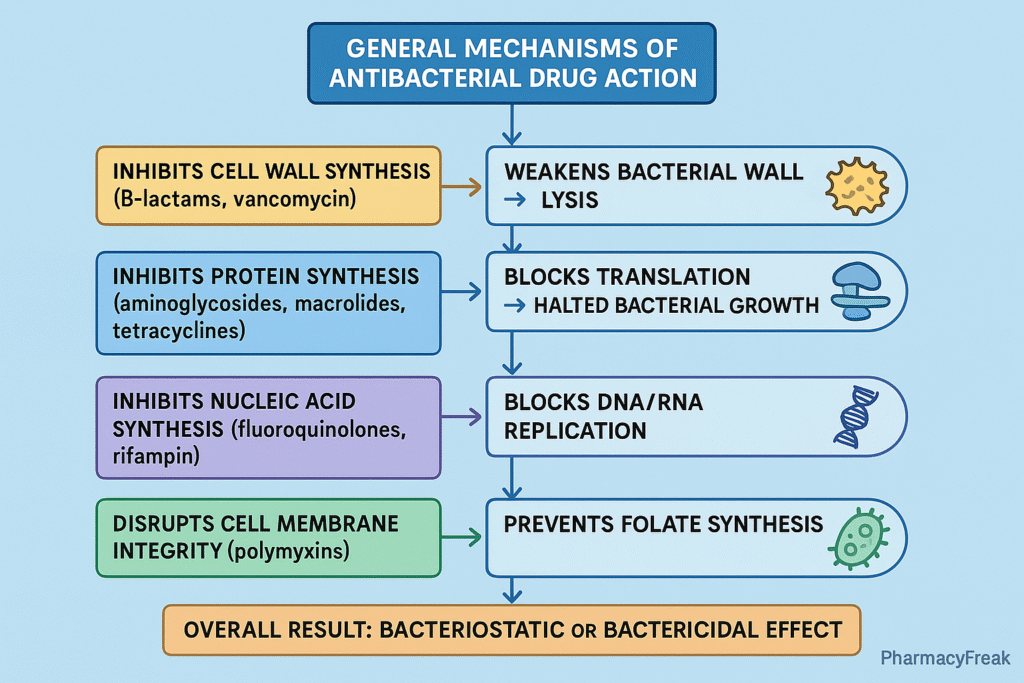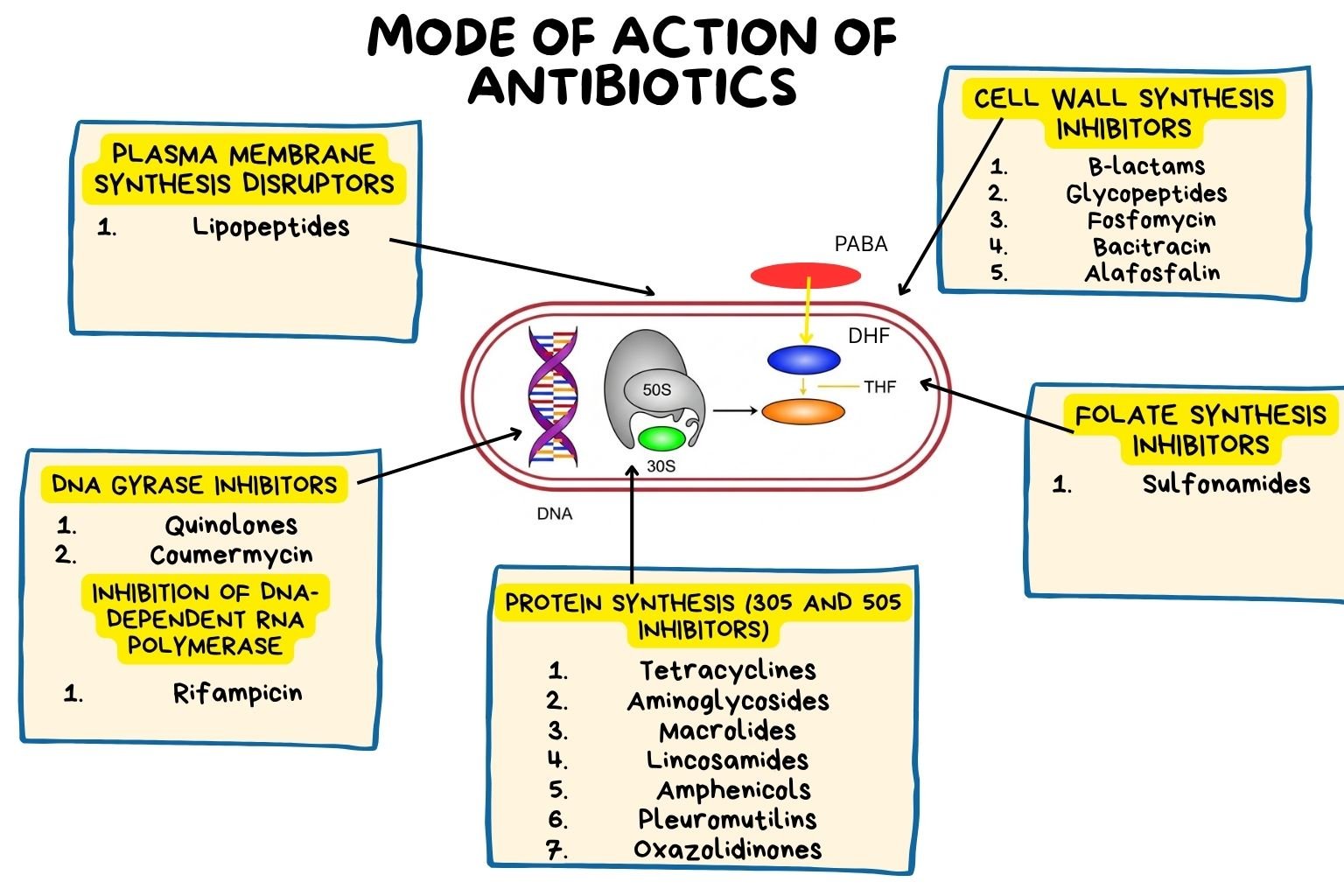Table of Contents
Introduction
Antibiotics are chemotherapeutic agents used to kill or inhibit bacterial growth by targeting essential microbial functions that differ from those in human cells. Mechanism of Action of Antibiotics involves interference with bacterial cell wall synthesis, protein translation, DNA or RNA replication, metabolic pathways, or membrane integrity. These mechanisms ensure selective toxicity—destroying bacterial cells while sparing host tissues. Understanding these mechanisms is vital for effective antibiotic therapy and to prevent antimicrobial resistance.

Mechanism of Action (Step-wise)
Antibiotics work through five main mechanisms, depending on their pharmacological class and bacterial target site.
1. Inhibition of Cell Wall Synthesis
- Target: Peptidoglycan layer in bacterial cell walls.
- Mechanism: Inhibits cross-linking of peptidoglycan chains by binding to penicillin-binding proteins (PBPs).
- Effect: Weakens the cell wall → osmotic rupture → bactericidal action.
- Examples:
- β-lactams: Penicillins, Cephalosporins, Carbapenems, Monobactams.
- Glycopeptides: Vancomycin, Teicoplanin — bind D-Ala-D-Ala terminus of peptidoglycan precursors.
2. Inhibition of Protein Synthesis
- Target: Bacterial ribosome (70S), composed of 30S and 50S subunits.
- Mechanism: Prevent translation of bacterial mRNA into functional proteins.
- Examples:
- 30S inhibitors: Aminoglycosides (Gentamicin, Amikacin), Tetracyclines.
- 50S inhibitors: Macrolides (Erythromycin, Azithromycin), Chloramphenicol, Clindamycin, Linezolid.
- Effect: Blocked protein synthesis → halted bacterial growth or death.
3. Inhibition of Nucleic Acid Synthesis
- Target: Enzymes involved in DNA replication or RNA transcription.
- Mechanism:
- Fluoroquinolones inhibit DNA gyrase (topoisomerase II) and topoisomerase IV.
- Rifamycins inhibit DNA-dependent RNA polymerase.
- Metronidazole generates free radicals that damage bacterial DNA (especially in anaerobes).
- Effect: Interference with replication and transcription → bactericidal activity.
4. Inhibition of Metabolic Pathways (Antimetabolites)
- Target: Folate synthesis pathway essential for nucleic acid production.
- Mechanism:
- Sulfonamides inhibit dihydropteroate synthase.
- Trimethoprim inhibits dihydrofolate reductase.
- Effect: Decreased tetrahydrofolic acid synthesis → inhibition of DNA and RNA formation.
- Example: Cotrimoxazole (Trimethoprim + Sulfamethoxazole) provides sequential blockade for synergy.
5. Disruption of Cell Membrane Function
- Target: Bacterial cytoplasmic membrane.
- Mechanism: Binds to membrane phospholipids, increasing permeability and causing leakage of cellular contents.
- Examples:
- Polymyxins (Colistin, Polymyxin B): Effective against Gram-negative bacteria.
- Daptomycin: Disrupts Gram-positive bacterial membranes by depolarization.
- Effect: Leakage of essential ions and metabolites → rapid cell death.
Comparative Mechanism Table
| Mechanism | Site of Action | Drug Class Examples | Effect |
|---|---|---|---|
| Inhibit cell wall synthesis | Peptidoglycan layer | Penicillins, Cephalosporins, Vancomycin | Bactericidal |
| Inhibit protein synthesis | 30S or 50S ribosome | Aminoglycosides, Macrolides, Tetracyclines | Bacteriostatic/Bactericidal |
| Inhibit nucleic acid synthesis | DNA or RNA enzymes | Fluoroquinolones, Rifamycins, Metronidazole | Bactericidal |
| Inhibit folate metabolism | Cytoplasmic enzymes | Sulfonamides, Trimethoprim | Bacteriostatic |
| Damage cell membrane | Cytoplasmic membrane | Polymyxins, Daptomycin | Bactericidal |
MCQs
1. The primary mechanism of β-lactam antibiotics is:
a) Inhibition of protein synthesis
b) Inhibition of peptidoglycan cross-linking
c) Inhibition of DNA replication
d) Folate antagonism
Answer: b) Inhibition of peptidoglycan cross-linking
2. Aminoglycosides act on:
a) 30S ribosomal subunit
b) 50S ribosomal subunit
c) 70S ribosome
d) Cell membrane
Answer: a) 30S ribosomal subunit
3. Sulfonamides inhibit:
a) DNA polymerase
b) Dihydropteroate synthase
c) RNA polymerase
d) Peptidoglycan transpeptidase
Answer: b) Dihydropteroate synthase
4. Fluoroquinolones inhibit which enzyme?
a) DNA gyrase
b) RNA polymerase
c) DNA polymerase
d) Topoisomerase I only
Answer: a) DNA gyrase
5. Rifampicin acts by:
a) Blocking cell wall synthesis
b) Inhibiting RNA polymerase
c) Binding ribosomal 50S subunit
d) Damaging bacterial membrane
Answer: b) Inhibiting RNA polymerase
6. Polymyxins act on:
a) Ribosomes
b) Cell membrane
c) Nucleic acid
d) Folate enzymes
Answer: b) Cell membrane
7. Which antibiotic class inhibits both DNA gyrase and topoisomerase IV?
a) Rifamycins
b) Fluoroquinolones
c) Sulfonamides
d) Macrolides
Answer: b) Fluoroquinolones
8. The antibiotic that damages bacterial DNA by free radicals is:
a) Metronidazole
b) Ciprofloxacin
c) Erythromycin
d) Clindamycin
Answer: a) Metronidazole
9. Folate synthesis inhibitors are:
a) Trimethoprim and Sulfonamides
b) Penicillin and Cephalosporin
c) Vancomycin and Imipenem
d) Linezolid and Chloramphenicol
Answer: a) Trimethoprim and Sulfonamides
10. Daptomycin acts primarily by:
a) Inhibiting protein synthesis
b) Depolarizing bacterial cell membranes
c) Blocking DNA polymerase
d) Preventing peptidoglycan linkage
Answer: b) Depolarizing bacterial cell membranes
FAQs
Q1. What are antibiotics?
Antibiotics are chemical agents used to inhibit or kill bacteria selectively without harming host cells.
Q2. What is the difference between bactericidal and bacteriostatic antibiotics?
Bactericidal drugs kill bacteria; bacteriostatic drugs inhibit growth, allowing host defenses to eliminate infection.
Q3. Why are human cells not affected by antibiotics?
Human cells lack bacterial targets such as peptidoglycan cell walls or 70S ribosomes.
Q4. Can antibiotics be combined?
Yes, certain combinations (e.g., β-lactam + aminoglycoside) enhance efficacy but should be used judiciously to prevent resistance.
Q5. What causes antibiotic resistance?
Mechanisms include enzyme production (β-lactamases), altered drug targets, efflux pumps, and permeability barriers.
Q6. Why are antibiotics ineffective against viruses?
Viruses lack bacterial structures (cell walls, ribosomes) that antibiotics target.
References
- Goodman & Gilman’s The Pharmacological Basis of Therapeutics
- Katzung’s Basic and Clinical Pharmacology
- Mandell, Douglas, and Bennett’s Principles and Practice of Infectious Diseases
- Harrison’s Principles of Internal Medicine
Related Internal Links

I am pursuing MBA in pharmaceutical management from NIPER Hyderabad with a strong academic record and proven success in national-level pharmacy entrance exams. I secured AIR 61 in NIPER 2024 (MS/M.Pharm) and AIR 27 in NIPER MBA, along with AIR 147 in GPAT 2024 and AIR 907 in GPAT 2023. I also achieved AIR 6 in AIIMS CRE-2025 for Drug Store Keeper and was selected as a Pharmacist (AIR 61) for ESIC. Additionally, I was the Runner-Up in Round 2 of the EY Case Study Competition.
At PharmacyFreak.com, I aim to guide future pharmacists through expert content, exam strategies, and insightful resources based on real experience and academic excellence.
Mail- harsh@pharmacyfreak.com
